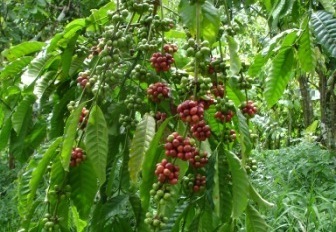Page 1 of 2Copper fungicides are still the most widely used protectant fungicides for tree crop disease control in the tropics, having undergone continuous development in formulation technology and spray application technique over the last 100 plus years
Tree crops in the wet and humid tropics are continually vulnerable to disease and long term crop loss. Virtually all the major tree crops including coffee, cocoa, tea, citrus, mango and avocado are evergreen trees which means that leaves, providing they remain healthy, have life span measured in years rather than months. Even rubber (Hevea brasiliensis), which is actually a deciduous tree, behaves like an evergreen with its period of leaf fall often lasting only a week before new leaves appear. Evergreen leaves, on the tree for long periods of time, are continually open to infection and invasion by fungal diseases and thus require long lasting protection from protectant fungicide deposits which can resist the all-round effects of tropical weathering.
Many tropical tree crops like cocoa and mango tend to produce new foliage in distinct and copious leaf flushes in response to seasonal changes related to alternating wet and dry seasons. This rush and flush of young leaves, lacking cuticle and wax bloom protection, is exceptionally vulnerable to fungal pathogens and foliar disease. Growth and expansion rates of newly emerged leaves and newly-set fruits are rapid with a correspondingly dynamic surface area requiring complete protection.
Moreover, high levels of intense tropical rainfall and accompanying high humidity provide the ideal conditions for infection, disease development and spread, while exerting high weathering and erosive pressures on protectant fungicide deposits on leaf and fruit surfaces.
Overall requirement is for the application of protectant fungicide using spray techniques that target the most vulnerable areas of the canopy and using formulations which provide tenacious fungicide deposits that are resistant to the erosive effects of tropical rainfall. Treatments must be applied at a dose x frequency that will ensure high enough fungicidally active deposits are maintained throughout the entire disease-susceptible period.
Protectant fungicides do exactly what their name says by forming a protective deposit over leaf and fruit surfaces to kill germinating fungal spores. As such they must be in place as a rain-resistant initial deposit before the spores alight on the leaf or fruit surface. These are purely contact fungicides. They do not enter the leaf and are therefore unable to eradicate established infections in the same way as systemically-acting curative fungicides.
The contemporary copper containing products are the particulate fixed copper fungicides, so called because they are composed of discrete particles with the copper fixed in what are essentially insoluble (sparingly soluble) salts of elemental metallic copper. The three main proprietary fixed copper fungicides are copper oxychloride, cupric hydroxide and cuprous oxide.
On a gram for gram basis, cuprous oxide contains the most active copper and is therefore the most efficacious (on a weight for weight basis). The molecular weight* of cuprous oxide [Cu2 0] is 143.00 with 127.00 (88 per cent) of this accounted for by the mass of two copper atoms. The equivalent figure for cupric hydroxide [Cu(OH)2] is 63.5/97.5 (65 per cent) and for copper oxychloride [3Cu(OH)2 .CuCl2] is 381.00/696.00 (55 per cent), respectively. Therefore on gram for gram basis cuprous oxide contains around 20-25% more fungicidal capacity than cupric hydroxide and copper oxychloride. *Calculations made using the atomic weights of Copper (Cu) – 63.5; Oxygen (O) – 16; Hydrogen (H) – 1; Chlorine (Cl) – 35.
Particle size distribution of the formulation plays a crucial role in deposit tenacity and weathering resistance over and above any inherent high tenacity of cuprous oxide as a fixed copper fungicide. For instance, cuprous oxide manufactured by Nordox (Oslo, Norway) has all particles within the 1µm to 5µm diameter range (80 per cent less than 2µm and 99 per cent less than 5µm) to give an unrivalled particle-size profile.
The high surface area to mass ratio of very small particles maximises their adhesion to crop plant surfaces making removal by growth movements or weathering more difficult. Larger particles (3-4µm) are more likely to be blown off plant surfaces by air movements (wind), physically dislodged by plant growth movements or washed off by rainfall.
Rain simulation studies carried out in the Netherlands using a rainfall intensity of 10mm/hour recorded significantly superior deposit retention for Nordox cuprous oxide over cupric hydroxide and copper oxychloride. The median particle size of the cuprous oxide was 1µm which was significantly smaller than 3µm for the other fixed copper fungicides.




